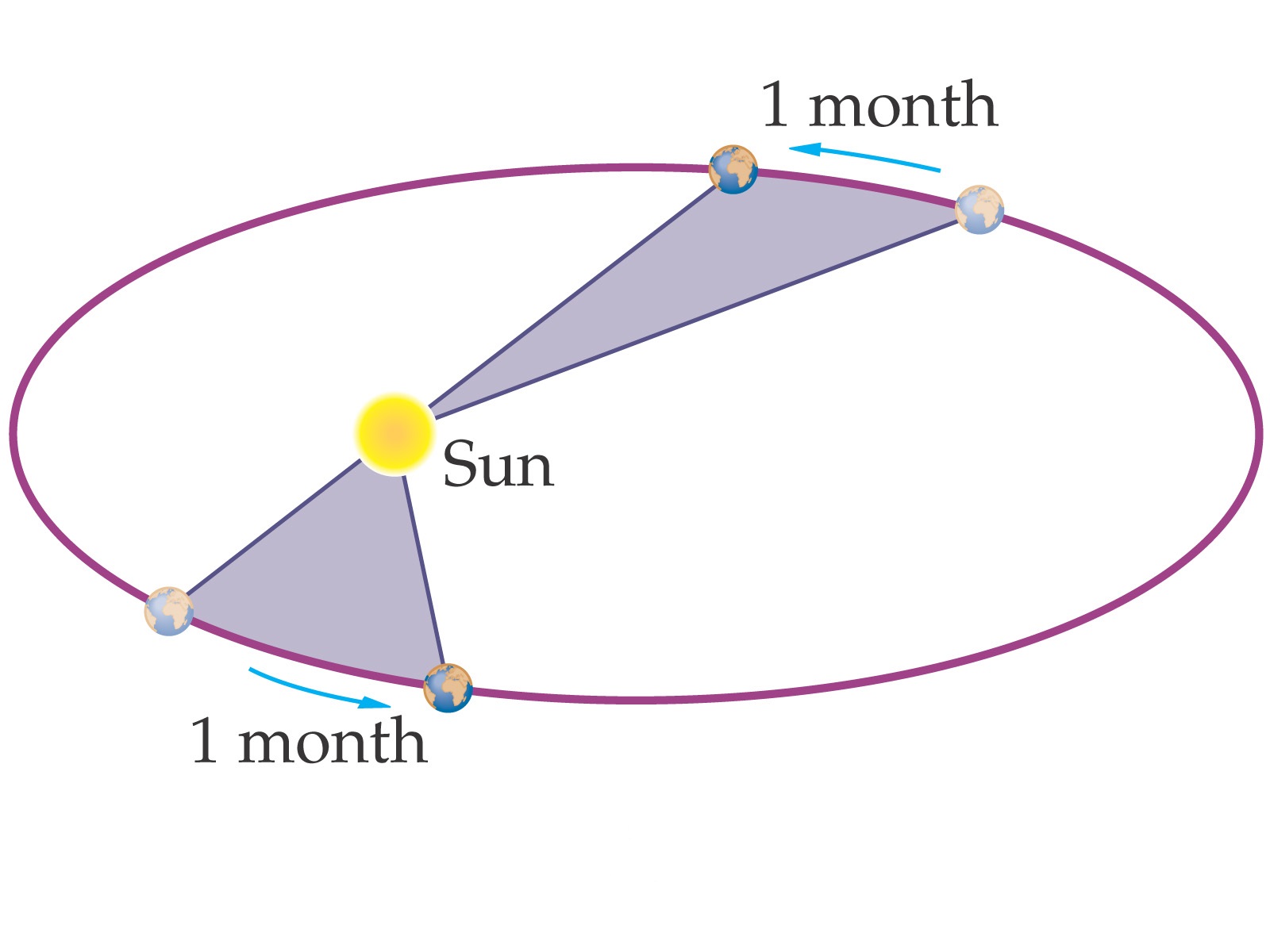- Kepler’s first law (law of elliptical orbit):-A planet moves round the sun in an elliptical orbit with sun situated at one of its foci.
- Kepler’s second law (law of areal velocities):- A planet moves round the sun in such a way that its areal velocity is constant.
- Kepler’s third law (law of time period):-A planet moves round the sun in such a way that the square of its period is proportional to the cube of semi major axis of its elliptical orbit.

T2 ∝ R3
Here R is the radius of orbit.
T2 = (4π2/GM)R 3
- Newton’s law of gravitation:-
 Every particle of matter in this universe attracts every other particle with a forcer which varies directly as the product of masses of two particles and inversely as the square of the distance between them.
Every particle of matter in this universe attracts every other particle with a forcer which varies directly as the product of masses of two particles and inversely as the square of the distance between them.
F= GMm/r2
Here, G is universal gravitational constant. G = 6.67 ´10 -11 Nm2 / kg2
- Dimensional formula of G: G = Fr2/Mm =[MLT-2][L2]/[M2] = [M-1L3T-2]
- Acceleration due to gravity (g):- g = GM/R2
- Variation of g with altitude:- g' = g(1- 2h/R), if h<<R. Here R is the radius of earth and h is the height of the body above the surface of earth.
- Variation of g with depth:- g' = g(1- d/R). Here g' be the value of acceleration due to gravity at the depth d.
- Variation with latitude:-
At poles:- θ = 90°, g' = g
At equator:- θ = 0°, g' = g (1-ω2R/g)
Here ω is the angular velocity.
- As g = GMe/Re2 , therefore gpole > gequator
- Gravitational Mass:- m = FR2/GM
- Gravitational field intensity:-
E = F/m
= GM/r2
- Weight:- W= mg
- Gravitational intensity on the surface of earth (Es):-
Es = 4/3 (πRρG)
Here R is the radius of earth, ρ is the density of earth and G is the gravitational constant.
- Gravitational potential energy (U):- U = -GMm/r
(a) Two particles: U = -Gm1m2/r
(b) hree particles: U = -Gm1m2/r12 –Gm1m3/r13 – Gm2m3/r23
- Gravitational potential (V):- V(r) = -GM/r
At surface of earth,
Vs= -GM/R
Here R is the radius of earth.
- Escape velocity (ve):-
 It is defined as the least velocity with which a body must be projected vertically upward in order that it may just escape the gravitational pull of earth.
It is defined as the least velocity with which a body must be projected vertically upward in order that it may just escape the gravitational pull of earth.
ve = √2GM/R
or, ve = √2gR = √gD
Here R is the radius of earth and D is the diameter of the earth.
- Escape velocity (ve) in terms of earth’s density:- ve = R√8πGρ/3
- Orbital velocity (v0):-
v0 = √GM/r
If a satellite of mass m revolves in a circular orbit around the earth of radius R and h be the height of the satellite above the surface of the earth, then,
r = R+h
So, v0 = √MG/R+h = R√g/R+h
In the case of satellite, orbiting very close to the surface of earth, then orbital velocity will be,
v0 = √gR
- Relation between escape velocity ve and orbital velocity v0 :- v0= ve/√2 (if h<<R)
- Time period of Satellite:- Time period of a satellite is the time taken by the satellite to complete one revolution around the earth.
T = 2π√(R+h)3/GM = (2π/R)√(R+h)3/g
If h<<R, T = 2π√R/g
- Height of satellite:- h = [gR2T2/4π2]1/3 – R
- Energy of satellite:-
Kinetic energy, K = ½ mv02 = ½ (GMm/r)
Potential energy, U = - GMm/r
Total energy, E = K+U
= ½ (GMm/r) + (- GMm/r)
= -½ (GMm/r)
- Gravitational force in terms of potential energy:- F = – (dU/dR)
- Acceleration on moon:-
gm = GMm/Rm2 = 1/6 gearth
Here Mm is the mass of moon and Rmis the radius of moon.
- Gravitational field:-
(a) Inside:-

(b) Outside:-

- GRAVITATIONAL POTENTIAL & FIELD DUE TO VARIOUS OBJECTS
Causing Shape
|
Gravitational Potential (V)
|
Gravitational Field (I or E)
|
Graph
V vs R
|
POINT MASS
| |||
 |  |  |  |
AT A POINT ON THE AXIS OF RING
| |||
 |   |  |  |
ROD
| |||
1. AT AN AXIAL POINT
| |||
 |
V = –
 |  |  |
2. AT AN EQUATORIAL POINT
| |||
 |  |  | |
CIRCULAR ARC
| |||
 |  |  |  |
HOLLOW SPHERE
| |||
 | 


 | 

 | |
SOLID SPHERE
| |||
 | 

  | 
  |  |
LONG THREAD
| |||
 |
V = ∞
|  | |
0 comments:
Post a Comment